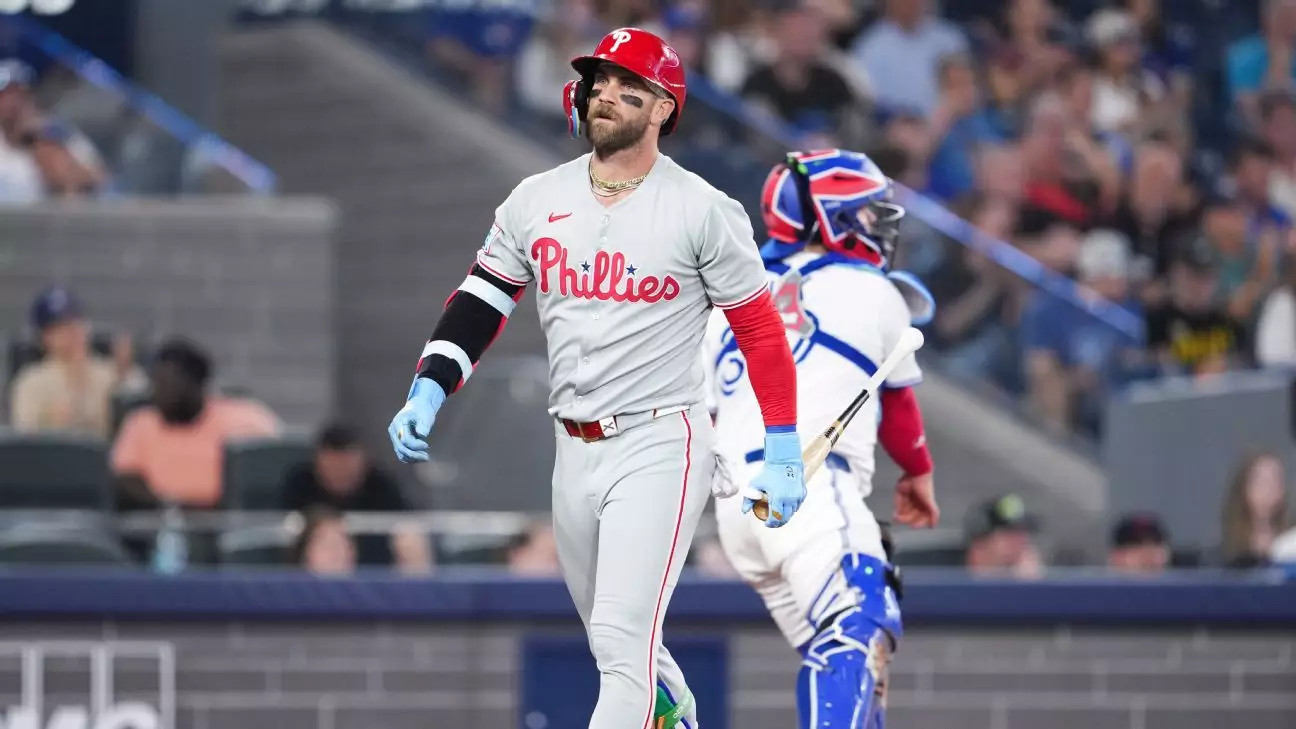Bryce Harper’s return to the Philadelphia Phillies roster after a nearly monthlong hiatus sparked a renewed sense of optimism for the team and fans alike, but it also serves as a reminder of the ongoing battle high-level athletes endure to stay competitive. Harper’s right wrist inflammation, an issue that has plagued him intermittently since last season, has left him in a precarious position—physically compromised yet still determined to contribute at an elite level. This ongoing wrist problem is more than a fleeting injury; it reveals the harsh realities professional athletes often face beneath the surface of high-profile success.
Harper, an eight-time All-Star and two-time National League MVP, endured significant pain last year, yet managed an impressive 30 homers, guiding the Phillies to an NL East title. This persistence reflects an intense personal and professional commitment often overlooked in sports narratives. Playing through pain can be valorized, but it also risks long-term health, something that teams and fans must conscientiously consider. As much as Harper’s skill and leadership are invaluable, the management of his health moving forward will be critical for sustaining his career longevity and the Phillies’ postseason ambitions.
The Impact on the Phillies’ Lineup and Strategy
While Harper’s absence saw the Phillies hovering around a .500 record at 13-14, they managed to maintain their hold on the NL East’s top spot, illustrating the depth and resilience of the roster. Yet, it’s clear that Harper’s return is not just about individual brilliance but also about stabilizing and energizing the lineup. Positioned at first base and batting third in his comeback game, Harper’s presence shakes up the Phillies’ offensive dynamics, providing both experience and power.
Manager Rob Thomson’s cautious optimism, opting for a “day-to-day” status based on Harper’s wrist condition, highlights the delicate balance teams must find between aggressive competition and player well-being. The possibility of Harper taking on the designated hitter role, where teammate Kyle Schwarber has excelled with 25 home runs, represents tactical flexibility but also acknowledges Harper’s physical limitations. This adaptive strategy suggests that the Phillies are trying to optimize Harper’s contributions while mitigating the risk of aggravating his injury—a prudent move in a sport where even minor physical setbacks can derail entire seasons.
New Talent and Team Evolution Amid Uncertainty
The emergence of rookie Otto Kemp in Harper’s absence adds an intriguing layer to the Phillies’ lineup considerations. Kemp’s versatility—capable of playing both infield and outfield positions—offers the team valuable options, especially as Harper’s health status remains uncertain. Kemp’s solid performance, with 10 RBIs in just 20 games, signals a promising future and injects youthful energy into the clubhouse.
The decision to designate infielder Buddy Kennedy for assignment to make room for Harper underscores the sometimes harsh realities of roster management, where difficult choices must be made to accommodate returning stars. This dynamic showcases the constant evolution of a major-league team, where players’ fortunes can shift rapidly based on injury, performance, and strategic needs.
A Career at a Crossroads: Investment and Expectations
Harper is in the seventh year of a monumental $330 million contract, underscoring the substantial investment the Phillies have placed in him as a franchise cornerstone. His leadership has been pivotal, steering the team through three consecutive playoff appearances, including a memorable 2022 NLCS MVP performance that propelled them to the World Series. However, with significant financial and emotional capital invested, Harper’s health and effectiveness bear immense weight on the Phillies’ current trajectory.
The decision to return while still managing pain signals Harper’s competitive spirit and understanding of his role’s magnitude. Yet, this delicate dance between playing through discomfort and safeguarding his long-term viability raises important questions about athlete management in modern professional sports. It highlights a broader conversation about how stars, contracts, and expectations intertwine, and how organizations balance immediate ambitions with sustainable career management.
In the end, Harper’s return is emblematic of the dual-edged nature of professional sports—triumph shadowed by vulnerability, brilliance tempered by physical limitations, and relentless drive balancing the pragmatic realities of aging and injury. His status will remain fluid, but his impact on the Phillies’ fortunes is undeniable, making every game he plays a critical chapter in this evolving story.


Leave a Reply